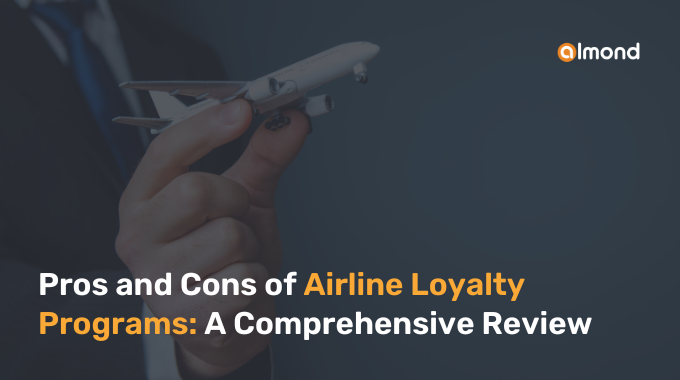Airline loyalty programs have been around for decades, offering frequent flyers the opportunity to earn miles or points that can be redeemed for flights, hotel stays, and other rewards. While loyalty rewards programs can significantly benefit travelers, they also have their fair share of drawbacks.
In this blog, we will review the pros and cons of airline reward programs and explore how airlines are navigating these challenges.
Pros of Airline Loyalty Programs
Airlines have introduced frequent flyer programs as these can increase loyal customers. Some advantages that lead to this conclusion are as follows:
Free Flights and Upgrades
The most significant benefit of airline reward programs is free flights and upgrades. Frequent flyers can earn miles or points by booking flights, using credit cards, or staying at partner hotels. These miles can be redeemed for flights, upgrades, or other rewards, significantly saving travelers.
Take an example of Delta Air Lines’ SkyMiles rewards program, which allows travelers to earn miles by booking flights, using Delta’s credit cards, or staying at partner hotels. These miles can then be redeemed for flights, upgrades, or other rewards, providing significant value to frequent flyers.
Priority Treatment
Another benefit of airline reward programs is the priority treatment given to frequent flyers. Elite members of reward programs are often given priority boarding, access to priority security lines, and other perks that make travel more comfortable and convenient.
For example, United Airlines offers a MileagePlus rewards program, which offers Premier status to its most frequent flyers. These members are given priority boarding, access to priority security lines, and other perks that make travel more comfortable and convenient.
Partner Programs
Airline reward programs often offer partner programs, allowing members to earn miles or points through other means, such as credit card spending, hotel stays, or car rentals. It provides more opportunities for members to earn rewards and other incentives, even when they are not traveling.
American Airlines offers its AAdvantage rewards program. It is considered one of the best airline loyalty programs, which allows members to earn miles through credit card spending, hotel stays, and car rentals. It provides more opportunities for members to earn rewards and redeem them for flights or other rewards.
Cons of Airline Reward Programs
Even though loyalty programs are profitable, some checks and balances should be considered. Airline companies must consider these checks while creating and running loyalty programs.
Complex Rules and Restrictions
In airline loyalty programs, redemption options can be limited, and blackout dates and other restrictions often make it challenging to redeem rewards.
For example, some airlines may limit the number of reward seats available, making it difficult to redeem miles for a flight. Similarly, some airlines may have blackout dates during peak travel times, making redeeming rewards during these periods challenging.
Expiration Dates
Another drawback of airline reward programs is the expiration dates that come with the rewards. Miles or points earned through reward programs may have expiration dates, making it challenging to accumulate enough rewards to redeem for a significant benefit.
For example, Delta Air Lines’ SkyMiles rewards program requires members to earn or redeem miles every 12 months to keep their account active. Failure to do so will result in the loss of any accumulated miles.
Devaluation of Points
Airline reward programs can also suffer from the devaluation of points, which occurs when airlines increase the miles or points required to redeem them. Frequent flyers can find it challenging to accumulate enough rewards to redeem for a significant benefit.
For example, in 2014, Delta Air Lines increased the miles required to redeem some of its rewards, making it more challenging for members to redeem them.
Navigating the Pros and Cons
While airline reward programs have pros and cons, airlines constantly work to navigate these challenges. For example, some airlines are introducing more flexible redemption options, making it easier for members to redeem their rewards. Others are introducing new partnerships to provide more opportunities for members to earn rewards.
For example, Delta Air Lines introduced its SkyMiles program, offering members benefits such as priority boarding, free checked bags, and discounted Delta Sky Club memberships. This program allows members to earn rewards without accumulating miles or points, providing more flexibility.
Another example is Southwest Airlines’ Rapid Rewards program, which allows members to redeem rewards for any available flight with no blackout dates. It provides members with more flexibility in redeeming their rewards and makes it easier to find available flights to redeem their rewards.
In addition to these changes, airlines are working to improve their reward programs by providing more value to their members. For example, some airlines are introducing more premium rewards, such as access to exclusive airport lounges, private jet charters, or experiences such as culinary tours or concert tickets.
Conclusion
Airline reward programs offer significant benefits for frequent flyers, such as free flights, priority treatment, and partner programs. However, they also come with drawbacks. That’s why airlines constantly work to improve their loyalty programs and provide more value to their members.
As travelers navigate the post-COVID world, airline loyalty programs may become even more important as airlines look to attract customers back to the skies. By understanding the pros and cons of these programs and how airlines navigate these challenges, travelers can make informed decisions about which reward programs to participate in and how to maximize their rewards.
Frequently Asked Questions
Here is some of the questions asked by people about airline loyalty programs.
1. What are the primary benefits of frequent flyer programs?
Frequent flyer programs offer a range of valuable benefits for travelers, from free or discounted flights to access to exclusive services and amenities. Common perks include priority boarding, extra baggage allowance, access to airport lounges, and even complimentary upgrades to business or first class. For travelers who fly often, these benefits can make a significant difference, enhancing comfort and providing cost savings on flights and travel services.
2. Are there any downsides to joining an airline loyalty program?
While airline loyalty programs are enticing, there are potential drawbacks to consider. Some loyalty programs impose restrictions on reward flight availability, making it difficult to redeem miles during peak times. Blackout dates, limited seat availability, and fees for redeeming miles on certain routes can also be frustrating. Additionally, higher loyalty tiers often require frequent travel on the same airline or within a specific airline alliance, which may not be practical for travelers who prefer flexibility or need to fly with multiple airlines.
3. Do frequent flyer miles expire if they’re not used regularly?
Yes, many frequent flyer programs have expiration policies. If an account is inactive for a prolonged period—meaning no points are earned or redeemed—miles may expire. This could be a drawback for less frequent travelers who may find it challenging to accumulate and use points within the expiration period. However, some airlines offer more flexible policies, allowing any activity on the account (like making a small purchase with a linked credit card) to reset the expiration clock.
4. Can I transfer my frequent flyer miles to other airlines or family members?
Generally, frequent flyer miles can be transferred within an airline alliance or to family members, though each program has different rules. Many airlines are part of alliances that allow members to redeem miles with partner airlines, broadening travel options and providing more flexibility in point redemption. Some programs also offer family pooling, allowing families to combine miles and redeem rewards faster. However, transferring miles outside of an alliance or to other loyalty programs is typically not allowed.
5. Is it worth joining a frequent flyer program if I only travel occasionally?
Even occasional travelers can benefit from joining a frequent flyer program, especially if the program has partnerships with hotels, car rentals, credit card providers, or retail brands. These partnerships allow members to earn points on everyday purchases, so even infrequent flyers can gradually accumulate points. However, occasional travelers might find it challenging to reach higher loyalty tiers or earn substantial rewards if they rarely fly with the same airline. It’s important to weigh the potential benefits against how often and how consistently you’ll use the program.
6. How do airline alliances affect the pros and cons of loyalty programs?
Airline alliances, like Star Alliance or OneWorld, allow loyalty program members to earn and redeem miles across multiple airlines within the alliance, providing more flight options and global reach. This setup benefits travelers by offering broader networks for earning and redeeming miles, making it easier to find flights that work for specific travel needs. However, not all partner flights earn points at the same rate, and some airlines within alliances have limited reward availability. Additionally, each airline may have unique rules for mile accrual and redemption, which can impact the overall value and ease of use of the frequent flyer program.
7. Are there any costs associated with frequent flyer programs?
Joining most frequent flyer programs is free, but reaching higher loyalty tiers can sometimes come with annual fees, and certain exclusive memberships may be available only through paid credit cards. Additionally, some airlines may charge fees for redeeming points on award tickets, especially on popular routes or during high-demand periods. Transferring points to other accounts or airline partners may also come with a fee. If a traveler frequently uses these services or redeems points on certain flights, the added fees can become a consideration.
8. What should I consider before committing to one airline’s loyalty program?
Before committing, it’s essential to evaluate your travel patterns and needs. Consider if the airline’s frequent flyer program covers routes you often fly, offers flexible redemption options, and aligns with your travel style. It’s also helpful to assess whether the airline belongs to an alliance, as this provides access to more flights and partners for earning and redeeming points. Check for restrictions like blackout dates, fees for redeeming rewards, and point expiration policies, as these can impact how easily you can use rewards. Also, consider how often you travel with the airline, as higher tiers and benefits generally require consistent loyalty to a single airline or alliance.
9. Do frequent flyer programs benefit business travelers more than leisure travelers?
Frequent flyer programs often cater to business travelers, who travel frequently and can more easily accumulate points, reach higher loyalty tiers, and enjoy premium benefits like lounge access and priority services. These perks make travel smoother and more comfortable, especially for those on tight schedules. However, leisure travelers can also benefit from loyalty programs by accumulating points over time through flights and partner purchases. While they may not reach elite status as quickly, they can still redeem miles for discounted flights or upgrades, which can enhance vacation travel experiences.
10. Can frequent flyer programs encourage travelers to spend more than they would otherwise?
Yes, frequent flyer programs can incentivize higher spending by encouraging travelers to prioritize a specific airline for rewards, purchase upgrades, or spend more on partner services like hotels and car rentals. The appeal of reaching higher tiers or accumulating more points can lead some travelers to make decisions based more on rewards than on cost efficiency. While this can be beneficial for travelers who regularly utilize the rewards, those who value flexibility or cost savings might find these incentives less beneficial if they are not flying frequently enough to justify the extra expenses.







